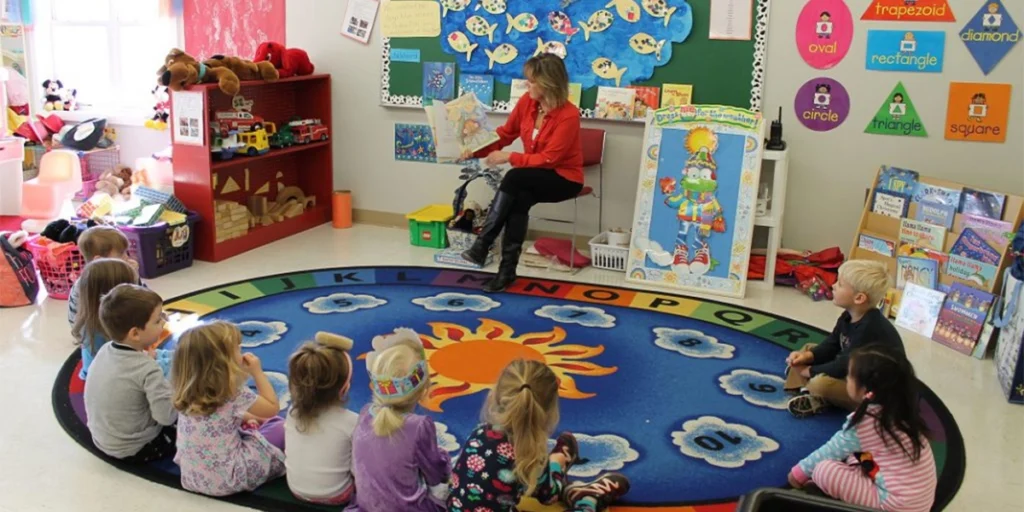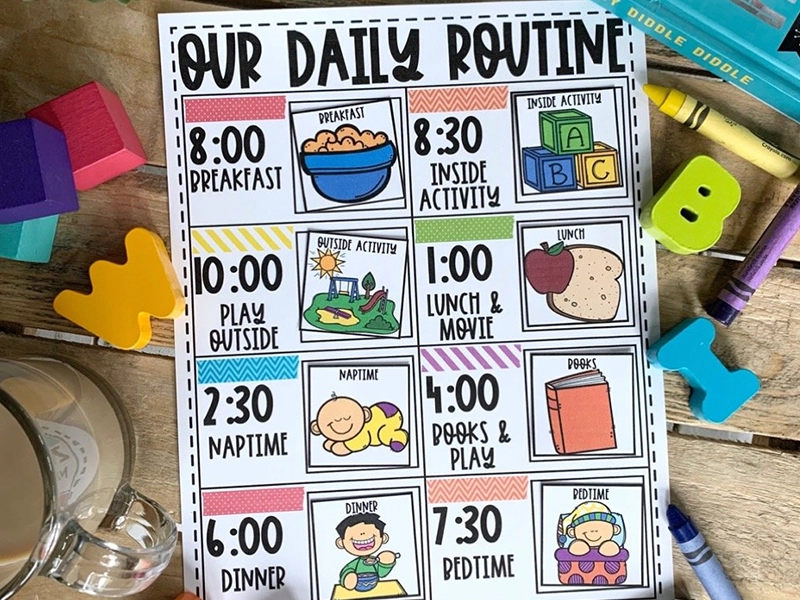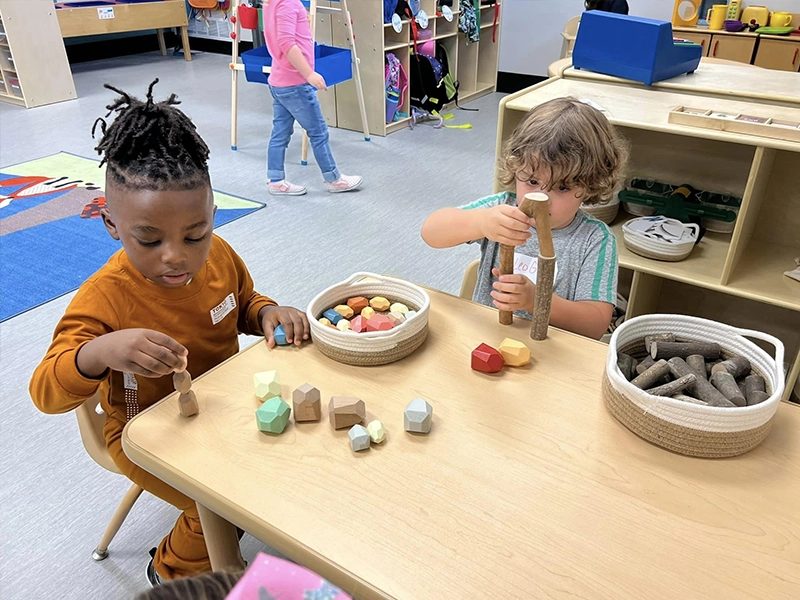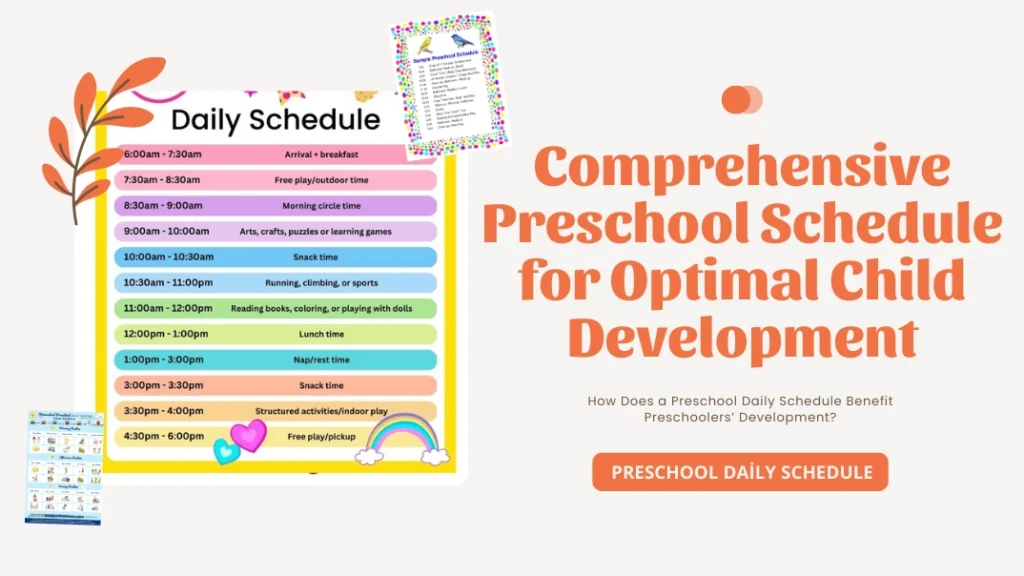A comprehensive preschool schedule is crucial for fostering optimal child development. Whether it’s a traditional classroom, a homeschool preschool schedule, or a daycare environment, a well-organized daily routine helps children feel secure and engaged. It ensures that every essential aspect of a child’s day is planned, covering learning, play, rest, and social interactions. In this article, we will explore the importance of a preschool schedule and how to create a structure that meets the diverse needs of young learners, from 2-year-olds to 4-year-olds.
Why is a preschool daily schedule important? A structured preschool schedule helps build emotional stability and encourages cognitive, physical, and social development. It ensures that children are engaged in various activities essential for their growth while making it easier for educators to manage the day efficiently.
We will also dive into different schedules, including half-day preschool schedules, full-day preschool schedules, and preschool visual schedules, to ensure a well-rounded understanding of implementing an optimal routine.

What is a Daily Preschool Schedule?
A daily preschool schedule is a well-organized plan outlining the activities, transitions, and daily routines. It incorporates all the critical development elements—cognitive, emotional, social, and physical—while ensuring enough flexibility to adapt to individual children’s needs. Schedules may vary depending on whether the program is a full-day preschool schedule, a half-day preschool schedule, or a homeschooled preschool schedule.
How to Create a Structured Preschool Schedule?
Establish Preschool Schedule Basics
Before designing your daily preschool schedule, it’s essential to establish the following basic components:
- Consistency: Children thrive on consistency. A predictable routine allows them to feel safe and understand what comes next, which reduces anxiety and fosters positive behavior.
- Balanced Variety: The schedule should include structured learning activities, free play, outdoor time, and rest periods. For example, a 3-year-old preschool daily schedule will focus more on short, engaging activities with frequent breaks, while a 4-year-old preschool daily schedule may include longer group learning sessions.
- Adaptability: While structure is important, flexibility should be built into the schedule. Some activities may take longer than planned, while others may need to be shortened depending on the children’s engagement and energy levels.
Below is an example of a well-balanced preschool daily schedule for a typical classroom:
| Time | Activity |
|---|---|
| 8:00 AM | Arrival and Free Play |
| 8:45 AM | Circle Time |
| 9:15 AM | Learning Centers (Small Group Activities) |
| 10:00 AM | Snack Time |
| 10:30 AM | Outdoor Play |
| 11:30 AM | Large Group Activity |
| 12:00 PM | Lunch |
| 12:30 PM | Nap/Rest Time |
| 1:30 PM | Free Play |
| 2:15 PM | Story Time and Departure |
This preschool daily schedule template is flexible enough to be adapted for various age groups, such as 2-year-olds, 3-year-olds, and 4-year-olds. Adjustments can include extended rest periods or structured learning for older children.
Use Flexibility to Your Advantage
In any preschool daily schedule, flexibility is essential for accommodating the unique needs of each child. For example, a group activity that excites the children may be extended, while transitions between activities might need extra time. Flexibility is also essential when considering weather changes, especially for outdoor play.
In a homeschool preschool schedule, flexibility can be maximized, allowing parents to adjust the flow of the day according to their child’s interests and energy levels. A daily schedule for preschool should include both predictable routines and moments for spontaneous learning experiences.
Manage Transitions Effectively
Managing transitions effectively is one of the critical challenges of creating a preschool daily schedule. Preschool visual schedules or preschool picture schedules can be incredibly helpful in easing transitions. These visual aids clearly show children what activity is next, reducing confusion and anxiety.
A picture schedule for preschool might look like this:
- Arrival and Free Play: Picture of children playing with toys
- Circle Time: Image of children sitting in a circle
- Snack Time: Icon of a snack or fruit
- Outdoor Play: Picture of a playground or children playing outside
- Nap Time: Image of a bed or resting child
Educators and parents can use a pictorial schedule for preschool to help children anticipate the next part of the day, making transitions smoother and more manageable.


Why Use a Preschool Daily Schedule?
The Importance of a Daily Schedule for Preschoolers
A well-structured preschool daily schedule offers numerous benefits for children:
- Predictability: Children feel more secure when they know what to expect. A consistent schedule fosters emotional security and reduces behavioral issues.
- Routine Building: By establishing daily routines, children learn essential life skills, such as how to transition from one activity to another, follow instructions, and manage their time.
- Developmental Support: The variety of activities included in a preschool schedule ensures that children engage in physical, social, emotional, and cognitive growth.
How Does a Preschool Daily Schedule Benefit Preschoolers’ Development?
A comprehensive preschool daily schedule plays a crucial role in promoting development across several domains:
- Cognitive Development: Activities like puzzles, building blocks, and storytelling during circle time help develop problem-solving skills and early literacy.
- Social and Emotional Development: Group activities, such as circle time and large group activities, promote social interaction, emotional regulation, and cooperation.
- Physical Development: Outdoor play, often included in a full-day preschool schedule, helps children develop gross motor skills, coordination, and physical health.
- Emotional Security: A predictable schedule reduces stress and anxiety, helping children feel more confident and comfortable throughout the day.
What Elements Should a Preschool Daily Schedule Include?
A balanced preschool daily schedule should include the following key components:
- Free Play: Allows children to explore their interests and engage in self-directed learning. Activities like imaginative play, building blocks, or art foster creativity.
- Outdoor Time: Outdoor play is essential for physical development and social interaction. A well-designed full-day preschool schedule should include at least 30 minutes to an hour of outdoor play.
- Structured Learning: Activities like circle time, storytime, and learning centers promote cognitive and social skills.
- Snack and Nap Time: Including snack and rest periods ensures children are well-nourished and energized for learning.


Elements of an Effective Preschool Classroom Schedule
Free Time to Choose
Incorporating free choice time into the preschool classroom schedule allows children to explore different activities based on their interests. Whether they prefer building with blocks, drawing, or reading, this time fosters independence and decision-making skills. The preschool daily schedule must offer enough variety during this free time to meet the children’s diverse interests.
For example, during free play in a 4-year-old preschool daily schedule, children might choose from learning centers, sensory play, or art projects. In a 3-year-old preschool daily schedule, the focus may be more on imaginative play and simple tasks.
| Time | Activity |
|---|---|
| 8:00 AM | Arrival and Free Play |
| 8:45 AM | Circle Time |
| 9:15 AM | Learning Centers (Small Group Activities) |
Outdoor Time
Outdoor play is essential to a preschool schedule, helping children develop their physical and social skills. In a typical full-day preschool schedule, outdoor time should occur at least once or twice a day, with activities like running, jumping, and climbing helping children develop gross motor skills.
For programs that operate on a half-day preschool schedule, a shorter period of outdoor play is still necessary to help children expend energy and practice social interaction.
Large Group Activities
Large group activities, such as circle time, group art projects, or storytelling sessions, provide social learning and collaboration opportunities. These activities also help children develop listening skills, follow directions, and participate in group discussions.
Incorporating large group activities into the schedule helps build community within the classroom.
Small Group Activities
Small group activities allow teachers to provide more personalized instruction, focusing on specific learning objectives tailored to smaller groups. This might include reading practice, puzzles, or math games. Small group learning is essential for developing fine motor skills, early literacy, and problem-solving.
Transitions
Managing transitions effectively is crucial for maintaining a smooth flow throughout the day. Tools like a preschool visual schedule or preschool picture schedule can help children anticipate the next activity. A visual schedule for preschool that uses pictures or icons for each activity (such as a book for storytime or a snack icon for snack time) helps ease children through the day with fewer disruptions.
Routines
Daily routines help children develop responsibility and independence. Routine tasks, such as washing hands before meals, tidying up after playtime, and preparing for nap time, can be seamlessly built into the preschool daily schedule. Over time, these routines promote self-reliance and establish good habits.


Preschool Daily Schedule Example
Below is a sample preschool daily schedule for a full-day program:
| Time | Activity |
|---|---|
| 8:00 AM | Arrival and Free Play |
| 8:45 AM | Circle Time |
| 9:00 AM | Learning Centers (Small Group Activities) |
| 9:45 AM | Snack Time |
| 10:00 AM | Outdoor Play |
| 10:45 AM | Large Group Activity (Art, Science, etc.) |
| 11:30 AM | Lunch |
| 12:00 PM | Nap/Rest Time |
| 1:30 PM | Free Play |
| 2:30 PM | Story Time and Departure |
This preschool schedule example balances structured learning, outdoor play, and rest, ensuring a holistic approach to child development.
Preschool Half-Day Schedule Example
For half-day preschool schedules, the structure is more condensed but still includes key activities like snacks, outdoor play, and storytime:
| Time | Activity |
|---|---|
| 8:00 AM | Arrival and Free Play |
| 8:30 AM | Circle Time |
| 9:00 AM | Small Group Learning |
| 9:45 AM | Snack Time |
| 10:00 AM | Outdoor Play |
| 10:45 AM | Story Time |
| 11:30 AM | Departure |
Preschool Visual Schedule
A preschool visual schedule is a great way to help children understand the flow of the day. Visual aids, such as pictures or icons representing different activities, provide children with clear visual cues about what’s coming next, making transitions smoother and reducing anxiety.
How to Create a Preschool Visual Schedule
Creating a visual schedule for preschool is simple but highly effective:
- Identify Key Activities: Start by listing the key activities of the day, such as circle time, snack time, outdoor play, and nap time.
- Choose Visuals: Represent each activity using pictures, icons, or symbols. For example, a picture of a book for storytime, a sun for outdoor play, or a sandwich for snack time.
- Display: Post the visual schedule in a prominent place where children can easily see and refer to it throughout the day.
A picture schedule for preschool is particularly beneficial for children with special needs, such as those with autism, who may require additional support to navigate transitions.

Adjust Timetables for Different Age Groups
Creating a preschool daily schedule that suits children’s developmental needs requires adjusting the schedule based on age. Children’s attention spans, energy levels, and learning capabilities change significantly as they grow. A 2-year-old preschool schedule will look very different from a 4-year-old preschool daily schedule, as younger children require more naps, shorter learning activities, and a heavier emphasis on free play.
Let’s break down the essential adjustments for each age group and explore how to optimize your preschool schedule for 2-year-olds, 3-year-olds, and 4-year-olds.
2-Year-Old Preschool Schedule
2-year-olds are at a stage where they are rapidly developing their motor skills, exploring their environment, and learning fundamental social interactions. Their attention spans are short, and they need frequent breaks, lots of opportunities for unstructured play, and longer naps to recharge.
Critical Elements of a 2-Year-Old Schedule:
- Short, Engaging Activities: Given their limited attention spans, each structured activity should last only 10-15 minutes. Activities like simple storytelling, songs, or sensory play are ideal for this age group.
- Frequent Free Play: 2-year-olds learn best through exploration and free play. Multiple free play sessions throughout the day allow them to develop their creativity, social skills, and independence.
- Longer Nap Times: A typical 2-year-old preschool schedule includes a longer nap time of 1.5 to 2 hours. Naps are critical for helping them recover their energy and process the new experiences they’re exposed to throughout the day.
- Snack Time: Since young children have smaller stomachs, frequent snack times are essential. This helps maintain their energy levels and prevents irritability, ensuring they stay focused during activities.
For 2-year-olds, the focus is on short, engaging tasks that allow them to develop their basic motor skills and explore the world around them. Free play and nap times are pivotal to their daily routine.
3-Year-Old Preschool Schedule
By age 3, children are developing more excellent social skills, longer attention spans, and a growing interest in structured activities. 3-year-olds can handle more extended periods of focused activities but still require plenty of time for free play and rest.
Critical Elements of a 3-Year-Old Schedule
- Increased Focus on Learning Activities: At this stage, children are more capable of engaging in structured activities for more extended periods—around 15-20 minutes. You can introduce educational elements such as simple puzzles, early math games, or interactive storytelling sessions.
- Cooperative Play: Social interactions are becoming more critical for 3-year-olds, so include group activities like team-based games or collaborative art projects. These activities help foster communication, sharing, and teamwork.
- Nap Time: 3-year-olds still need naps, but the duration may decrease slightly compared to younger children. A 1 to 1.5-hour nap helps them recharge and prepares them for the rest of the day’s activities.
- Learning Centers: Include learning centers where children can explore specific interests. At this age, children may enjoy sensory tables, building blocks, or role-play areas where they can practice imaginative play.
In a 3-year-old preschool schedule, activities are slightly longer, with more structured learning incorporated into the day. However, free play and social activities remain essential for developing communication and motor skills.
4-Year-Old Preschool Schedule
By the time children reach four years old, they are preparing for kindergarten and can handle much more structured learning. A 4-year-old preschool daily schedule will include more extended academic periods and sophisticated group activities, but free play and physical activities are still crucial for maintaining balance.
Critical Elements of a 4-Year-Old Schedule:
- Longer Structured Learning: 4-year-olds are ready for extended learning periods, such as 20-30 minutes per activity. These could include phonics, early writing exercises, simple math tasks, and science experiments. These activities help children develop the skills they will need in kindergarten.
- Reduced Nap Time: As 4-year-olds prepare for kindergarten, nap times may be reduced or replaced with quiet time. A 30 to 60-minute rest period allows children to recharge without feeling too groggy.
- Increased Responsibility: Children can start taking on more responsibility at this age. Simple tasks like tidying up after activities or helping prepare materials for group learning foster independence and self-discipline.
- Group Learning: More structured group learning sessions like phonics practice or group science projects are ideal for developing academic readiness. 4-year-olds can also participate in problem-solving activities that encourage teamwork and critical thinking.
The 4-year-old preschool schedule emphasizes longer, more structured learning sessions and reduces nap time, preparing children for the transition to kindergarten. Activities such as letter recognition, writing practice, and collaborative learning become more prominent, helping build a foundation for formal education.
Essential Adjustments Based on Age Groups
In summary, the preschool schedule should be designed to meet the developmental needs of the children:
- 2-year-olds: Focus on shorter activities, longer naps, and plenty of free play to support their exploration and physical development.
- 3-year-olds: Increase structured learning while maintaining enough free play and nap times to help them recharge and develop socially.
- 4-year-olds: Emphasize kindergarten readiness with extended learning periods, reduced nap times, and more academic-focused activities like phonics, math, and science.
Whether you’re designing a half-day preschool schedule or a full-day preschool schedule, these age-based adjustments ensure that children are engaged, learning, and well-rested according to their developmental stage.
Comparative Preschool Schedule for 2-, 3-, and 4-Year-Olds
| Time | Activity | 2-Year-Olds | 3-Year-Olds | 4-Year-Olds |
|---|---|---|---|---|
| 8:00 AM | Arrival and Free Play | Arrival and Free Play | Arrival and Free Play | Arrival and Free Play |
| 8:30 AM | Circle Time | Circle Time (Songs, Simple Stories) | Circle Time (Songs, Interactive Stories) | Circle Time (Storytelling, Letters Practice) |
| 8:45 AM | Snack Time | Snack Time | Snack Time | Snack Time |
| 9:00 AM | Outdoor Play | Outdoor Play (Exploration) | Outdoor Play (Structured and Free Play) | Outdoor Play (Physical Education) |
| 9:30 AM | Learning Activity/Small Groups | Sensory Play or Art Activities | Small Group Learning (Art, Math Games) | Group Learning (Math, Science) |
| 10:00 AM | Free Play/Learning Centers | Free Play in Learning Centers | Outdoor Play Continued | Art/Creative Projects |
| 10:30 AM | Large Group Activity | Group Activity (Simple Games, Music) | Large Group Activity (Music, Dance) | Learning Centers (Writing, Puzzles, STEM) |
| 11:00 AM上 | Lunch | Lunch | Lunch | Lunch |
| 11:30 AM | Nap/Rest Time | Nap Time (1.5 to 2 hours) | Nap Time (1 to 1.5 hours) | Quiet Time/Nap Time (30-60 minutes) |
| 1:30 PM | Free Play/Quiet Activities | Quiet Free Play (Puzzles, Blocks) | Learning Centers (Puzzles, Dramatic Play) | Learning Centers (Writing, Puzzles, STEM) |
| 2:00 PM | Story Time and Departure | Departure | Story Time and Departure | Story Time and Departure |
Key Differences:
- Circle Time: As children age, the content and complexity of circle time activities increase. 2-year-olds engage in simple songs and stories, while 4-year-olds begin practicing letters and numbers.
- Outdoor Play: Outdoor play remains essential for all ages, but the structure becomes more defined for older children. 2-year-olds focus on exploration, while 4-year-olds participate in more structured physical education.
- Learning Activities: 2-year-olds focus on sensory play and simple art activities, while 3-year-olds and 4-year-olds transition into more structured small group learning, including early math and science for the older children.
- Nap Time: 2-year-olds require the longest nap time (up to 2 hours), while 3-year-olds may nap for 1-1.5 hours. 4-year-olds have shorter naps or quiet time (30-60 minutes) to prepare for kindergarten.
- Learning Centers: Learning centers play a critical role for all ages, but the complexity increases with age. 2-year-olds might focus on simple free play, while 4-year-olds engage in more academic tasks such as writing and STEM-related activities.
This comparison table clearly outlines how the preschool schedule evolves as children grow, with adjustments to accommodate their developmental stages. It ensures that each age group receives the appropriate balance of structured learning, free play, and rest.
Plan the Best You Can
While having a well-structured schedule is essential, flexibility and adaptability are key. Preschool days often bring unexpected changes, whether a child needs more rest or an activity taking longer than anticipated. The most important thing is to maintain a balance between learning, play, and rest and to be open to adjusting the schedule as needed.



